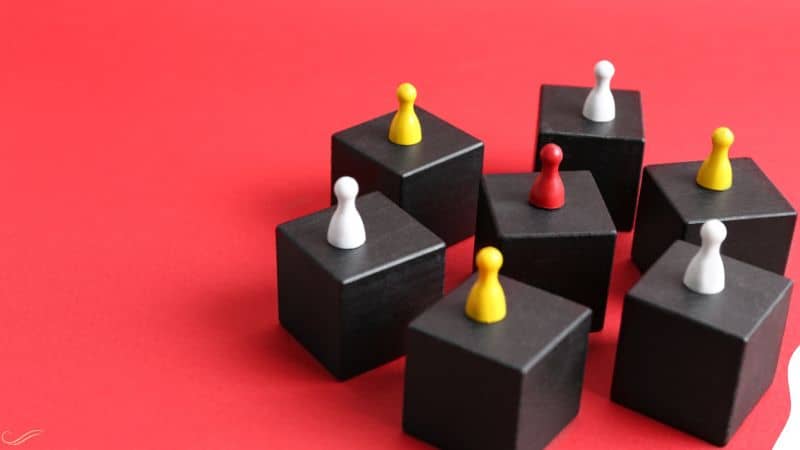Team-building strategies help you focus your efforts on a few things that will drive your business success. You don’t have to guess what to do next because you know precisely what you are going to do.
Building a winning team takes time and effort, but the benefits are worth it. By implementing these ten effective team-building strategies, you can help create a high-performing team better equipped to tackle challenges and achieve success.
🚀 “Level up your leadership game. We train leaders to think big, act decisively, and make a real impact. Ready to step up and start leading like you mean it?”
What are team-building strategies?
Team-building strategies are activities and techniques that may improve collaboration, communication, trust, and mutual understanding among team members.
Team building strategies can include various exercises, games, workshops, and other initiatives designed to strengthen the bond between team members, foster a positive team culture, and ultimately enhance team performance and productivity.
The purpose of team-building strategies is to help team members work together more effectively, resolve conflicts, and achieve common objectives while enjoying a supportive and cohesive working environment.
10 Team Building Strategies
You don’t really need many team-building activities. In my Team Mastery Workshops, I encourage teams to work on 10 to 12 strategies which I teach in seven workshops.
Allow me to share with you some of these effective team-building strategies.

1. Set Clear Goals and Objectives
Setting clear goals and objectives is essential for building a high-performing team. Make sure everyone understands what they’re working towards and how their contributions fit into the bigger picture.
Here are some ways to help a team set goals:
Define the team’s purpose: Clarify the team’s overall purpose and what it aims to achieve. This helps the team understand its role and identify the key objectives it needs to meet.
Identify SMART goals: SMART stands for Specific, Measurable, Achievable, Relevant, and Time-bound. Setting SMART goals ensures that the team’s objectives are clear and actionable.
Involve the team: Encourage the team to participate in setting its goals. This not only helps team members feel more invested in the process but also leads to better outcomes because team members bring different perspectives and ideas to the table.
Prioritize goals: Prioritizing goals helps the team focus on the most important objectives and avoid getting sidetracked by less critical tasks. Prioritization should be based on the team’s overall purpose and its ability to achieve the goal within the given timeframe.
Monitor progress: Regularly monitoring progress against the team’s goals is critical to ensure that the team stays on track and makes adjustments as necessary. Celebrate small victories and provide constructive feedback to help the team stay motivated and on track.
Align goals with larger organizational objectives: Finally, ensure that the team’s goals are aligned with the larger objectives of the organization. This helps to create a sense of purpose and helps the team understand how its work contributes to the success of the organization as a whole.

2. Clearly Define Roles and Responsibilities
Clearly defining roles and responsibilities is essential for building a high-performing team. Each team member should understand their role and how it fits into the overall team objectives.
Here are some ways to define team roles and responsibilities:
Identify team goals: Start by identifying the goals of the team. This will help you understand the roles and responsibilities required to achieve those goals.
Conduct a skills and strengths assessment: Identify the skills and strengths of each team member. This will help you understand what each person can contribute and what their roles are best suited for.
Determine critical tasks and activities: Identify the key tasks and activities that must be done to achieve the team’s goals.
Assign these tasks and activities to specific team members based on their skills and strengths.
Define roles and responsibilities: Based on the tasks and activities identified, define the roles and responsibilities of each team member.
Be clear about what is expected of each team member and how their work will contribute to their goals.
Ensure clarity and communication: Everyone on the team understands their roles and responsibilities. Encourage open communication and feedback to ensure everyone is on the same page.
Review and revise regularly: Review and revise team roles and responsibilities as needed. This will help ensure that the team adapts to changing circumstances and that everyone works together effectively.
Consider using a RACI matrix: A RACI (Responsible, Accountable, Consulted, and Informed) matrix is a tool that can help clarify team roles and responsibilities. It outlines who is responsible for a task, who is accountable for its completion, who needs to be consulted, and who needs to be informed.

3. Encourage Open Communication
Encouraging open communication is crucial for building a culture of trust and collaboration. Provide opportunities for team members to share their thoughts and ideas, and create a safe and supportive environment where everyone feels comfortable speaking up.
Here are some ways to encourage open and honest communication in teams:
Lead by example: As a team leader, it is important to model open and honest communication.
Be transparent with your team, share your thoughts and feelings, and encourage feedback and input from others.
Create a safe space: Encourage your team to speak up by creating a safe and supportive environment where team members feel comfortable expressing their opinions and concerns without fear of retribution or judgment.
Listen actively: Demonstrate that you are listening actively to what your team members have to say.
Use active listening techniques, such as paraphrasing and summarizing, to ensure that you understand their perspectives.
Encourage diversity of thought: Embrace diversity of thought and encourage your team members to bring different perspectives and ideas. This will help your team develop more creative solutions and make better decisions.
Use non-judgmental language: Use non-judgmental language when communicating with your team.
Avoid labeling, blaming, or attacking individuals; instead, focus on the issues and how they can be addressed.
Provide feedback: Provide regular feedback to your team members, both positive and constructive. Help them understand how their contributions are perceived and how they can improve.
Celebrate successes: Celebrate team successes, no matter how small they may be. This will help build morale and encourage your team to continue to work together towards a common goal.
Use technology: Use technology, such as online forums or messaging apps, to encourage communication between team members. This can be particularly useful if your team is distributed or remote.

4. Foster Collaboration
Collaboration is key to successful team building. Encourage team members to work together to solve problems and complete tasks. Provide opportunities for team members to share their expertise and knowledge.
Here are some ways to foster collaboration in teams:
Set common goals: Ensure that all team members are working towards a common goal. This will help create a shared purpose and encourage collaboration.
Encourage open communication: Create a culture of open communication where team members feel comfortable sharing their thoughts and ideas. Encourage active listening and respectful communication.
Foster trust: Build trust among team members by being transparent, reliable, and supportive. Encourage teamwork and emphasize the importance of each team member’s contribution.
Assign team roles and responsibilities: Clearly define team roles and responsibilities to ensure that each team member understands their contribution to the team’s success. This will help avoid duplication of effort and encourage collaboration.
Establish team norms: Establish clear norms for how the team will work together. This can include guidelines for communication, decision-making, and conflict resolution.
Encourage diversity: Embrace diversity of thought and encourage different perspectives. This can lead to more creative solutions and better decision-making.
Provide opportunities for team building: Provide opportunities for team building, such as team outings or activities. This can help build trust and strengthen relationships among team members.
Use collaboration tools: Use collaboration tools, such as online project management software or communication apps, to facilitate collaboration and communication among team members.
Celebrate successes: Celebrate team successes, no matter how small they may be. This can help build morale and encourage continued collaboration.
Provide regular feedback: Provide regular feedback to team members, both positive and constructive. This can help team members understand how their contributions are perceived and how they can improve.

5. Build Trust
To build trust, encourage team members to be open and honest with each other, set clear expectations and goals, and provide opportunities for team members to work together on collaborative projects.
Here are some ways to build trust in teams:
Lead by example: As a team leader, model the behavior you want to see in your team. Be transparent, reliable, and accountable.
Notice that you will find “lead by example” in most team-building strategies. That’s because, as a leader, people learn from what you do.
Encourage open communication: Create a safe space for team members to share their thoughts and ideas. Encourage active listening and respectful communication. The first three strategies I have mentioned above also require that you communicate effectively.
Show empathy: Show empathy towards team members by acknowledging their feelings and perspectives. This can help build rapport and strengthen relationships.
One tool that I use is the empathy map.
No, it won’t give you empathy. But using it can help you consider where people are coming from.
Be reliable: Follow through on your commitments and deliver on your promises. This can help establish a sense of reliability and trustworthiness.
.You must be consistent too.
Build rapport: Take the time to personally get to know your team members. This can help build rapport and foster trust.
In 10 Steps to Leadership Excellence, I recommend building stronger relationships as the first step. Precisely because leadership is not just head-to-head; it is heart-to-heart.
You must develop a trusting relationship with your team.
Share credit: Share credit for team successes with all team members. This can help build a sense of unity and encourage collaboration.
The worst leaders are those who take the credit for your efforts.
This reminds me of a government employee who said he does not trust his boss because when it comes to getting points for work done, his boss gets three times the points for all his efforts. We can talk about it some other day.
The point is simple: give your team credit due to them.
Be transparent: Be transparent about decisions and processes that affect the team. Build trust by showing that you have nothing to hide.
Foster collaboration: Encourage collaboration and teamwork. Build trust by demonstrating that everyone’s contributions are valued.
Address conflicts: Address conflicts and disagreements constructively and respectfully. Be willing to listen to and address concerns.
Provide support: Provide support and resources to team members when needed. Care about their well-being and success.
Following these tips can create a culture of trust in your team to help you achieve your goals and work together more effectively.

6. Provide Ongoing Training and Development
Ongoing training and development are essential for building a high-performing team. Provide opportunities for team members to learn new skills and take on new challenges. Train your team leaders too.
Deliberate and well-designed training is an excellent team-building strategy. In fact, most teams in the Philippines need this kind of team building.
Competency-based training can multiply your results without spending much money on team-building packages.
Here are some ways team leaders can provide ongoing training and development to their teams:
Identify training needs. Conduct a training needs assessment to identify the areas where your team members need the most support.
Design training programs tailored to the specific needs of team members.
Offer on-the-job training. Provide on-the-job training opportunities like shadowing or mentoring to help team members develop new skills and learn from more experienced colleagues.
Provide access to online courses. Offer access to online courses and resources, such as LinkedIn Learning or Coursera, to allow team members to develop new skills at their own pace.
Or you can also contact me. I can design for your company online courses that will guide your team for a year.
Host training workshops. Host training workshops, either in-person or online, to provide hands-on learning opportunities and facilitate group discussions and collaboration.
Provide coaching. Offer one-on-one coaching to help team members develop specific skills or address areas needing improvement.
Encourage self-directed learning. Encourage team members to take ownership of their learning and development by reading industry publications, attending conferences, or pursuing relevant certifications.
If there is anything that can help Filipino teams succeed, it is this advice. But this is challenging. You can only do this if you dare to model the way.
Celebrate learning. Recognize and celebrate when team members complete training or develop new skills. This can help build morale and encourage continued learning.
There was a time when Toastmasters International informed employers of your achievements in the organization. Because of this, my bosses learned I was an achiever (I still am!)
You can do the same for your organization.
By providing ongoing training and development opportunities, team leaders can help their teams stay current and develop the skills they need to achieve their goals.

7. Celebrate Successes
Celebrating successes is an important way to build morale and strengthen team relationships. Take time to acknowledge individual and team achievements and provide positive feedback and recognition for a job well done.
Here are some ways team leaders can celebrate success:
Acknowledge individual contributions. Recognize the individual contributions of each team member, and show appreciation for their efforts.
I remember a lady showed me a laminated napkin. In it, the boss appreciated her contribution to the success of a project. To her, that was the biggest compliment she got from her boss.
Acknowledging people does not take a rocket scientist to figure out, right?
Celebrate as a team. Celebrate team successes as a group, and encourage everyone to participate in the celebration.
I learned this when I was in high school. Team celebration is always special. For a moment, you felt valued and respected. And for most people, that moment last forever.
Offer public recognition. Publicly recognize team successes in company meetings or through newsletters, social media, or other internal communication channels.
On our way home from Batangas the other day, I saw a sign congratulating someone who passed the engineering licensure examination. I recognized him as the person who just served as our go-to.
It is a good feel to know a person. So, the recognition is not just for the perceiving receiving it, but also for everyone who works with that person.
Provide rewards. Consider providing rewards or incentives to team members who contributed significantly to the team’s success. This can be in the form of bonuses, time off, or other benefits.
Rewards remind me of The former CEO of Southwest Airlines Herb Kelleher. He was able to bring the company to new heights because of gave rewards to all employees.
Provide growth opportunities. Celebrate success by providing growth opportunities, such as training or mentorship programs, that help team members build their skills and advance in their careers.
Many companies provide training to those who are deficient in skills. And for a good reason, many people don’t feel good about training.
But it is different when people know that those sent to training programs are achievers. Then, training becomes a badge of honor.
Have a team outing: Plan a fun team outing, such as a sports event, a group activity, or an adventure outing to celebrate success and build team morale.
And remember, we can help you facilitate your team-building programs.
Show gratitude. Show gratitude to the team by thanking them for their hard work and dedication. A simple gesture but can go a long way in making team members feel appreciated.
Provide time off. Provide additional time off, such as a half-day or a day off, to celebrate team success and allow team members to recharge.
Celebrating success is a crucial way for team leaders to show their appreciation for their team members’ hard work and dedication. You can create a culture of celebration to encourage continued success and help build a strong, motivated team.

8. Organize Team Building Activities
Organize team-building activities that encourage team members to work together and build relationships outside work. Activities can be anything from a team lunch to an outdoor team-building experience.
Here are some ways team leaders may organize team-building activities:
Plan a retreat. Get away from the office and engage in team-building activities. You can do outdoor activities, such as hiking or team sports, or indoor activities, such as team-building workshops or games.
Volunteer together:. Organize a volunteer event where the team can work together to give back to the community. Build a sense of camaraderie and purpose.
Have a team lunch or dinner. Organize a team lunch or dinner in the office or at a restaurant to give team members a chance to connect and socialize outside of work.
Create a team-building challenge. Create a team-building challenge that requires collaboration and problem-solving skills. You can try a scavenger hunt or an escape room challenge.
Organize a team-building workshop: Hire a professional facilitator to lead a workshop focusing on improving communication, collaboration, and problem-solving skills.
A workshop isn’t just a package of team-building games. Your goal is to provide your team with opportunities to learn new skills.
Play team-building games: Play games that require teamwork and problem-solving skills. Use simple team-building activities that really build teams.
By organizing team-building activities, team leaders can foster a sense of connection, collaboration, and purpose among team members.

9. Foster a Positive Work Environment
Foster a positive work environment by encouraging positivity and discouraging negativity. Provide a supportive workplace culture where team members can thrive.
Here are some ways team leaders may foster a positive work environment:
Lead by example. As mentioned, you will read this often. Team leaders must model positive behavior, such as punctuality, respect, and professionalism, to create a positive workplace culture.
Encourage open communication. Create an environment where team members feel comfortable sharing their thoughts and ideas openly and respectfully.
Recognize and appreciate team members: Recognize their achievements and contributions, and show appreciation for their hard work and dedication.
Foster teamwork and collaboration. Encourage teamwork and collaboration by creating opportunities for team members to collaborate on projects and share their skills and knowledge.
Provide regular feedback. Provide regular feedback to team members on their performance and constructive feedback to help them improve.
Support work-life balance: Encourage work-life balance by offering flexible work arrangements, such as flexible schedules, telecommuting, or time off when needed.
Create a positive physical environment. Create a comfortable, clean, and inviting workspace, and provide team members with the tools and resources they need to do their work.
Foster diversity and inclusion. Foster a diverse and inclusive workplace by hiring a diverse team, celebrating differences, and creating an environment where everyone feels welcome and valued.
By fostering a positive work environment, team leaders can help improve morale, productivity, and teamwork, leading to better results and greater success for the team and the organization.

10. Review and Adjust
Review your strategies regularly and adjust them as needed. Continuously assess your team’s strengths and weaknesses and adjust your strategies accordingly.
Here are some ways a team can review its strategies:
Conduct a SWOT analysis: A SWOT (Strengths, Weaknesses, Opportunities, and Threats) analysis is a useful tool for reviewing strategies.
It can help identify areas of strength, weaknesses to address, potential opportunities, and threats to mitigate.
Measure progress against goals: Regularly measure progress against the team’s goals to see if strategies are working.
Use metrics that are specific, measurable, achievable, relevant, and time-bound (SMART).
Review market trends and customer feedback: Review market trends and customer feedback to see if the team’s strategies are aligned with the needs of the market and customers.
Analyzing feedback can help identify areas of improvement and opportunities to enhance the team’s strategies.
Hold regular team meetings: Hold regular team meetings to discuss the team’s strategies and progress.
Encourage open communication and feedback to help identify areas of improvement and refine strategies.
Conduct a peer review: Have team members conduct a peer review of each other’s work. Identify areas of improvement and bring fresh perspectives to the team’s strategies.
Consider external input: Seek input from external sources, such as industry experts or consultants, to review the team’s strategies.
This can provide valuable insights and help identify opportunities for improvement.
Conduct a retrospective: Conduct a retrospective at the end of a project or milestone to review the team’s strategies and identify areas of improvement for the next project.
This can help ensure the team continuously learns and refines its strategies.

🎯 “Imagine a team that’s not just working together but truly connected. Our workshops build the trust, energy, and alignment that every high-performing team needs. Ready to make it happen?”



When you hear “team strategy,” it might feel like a big word meant for boardrooms and C-suite meetings. But here’s the truth: strategy is just about knowing your priorities. It’s about asking, What will move the needle for us? Get that right, and you’ll steer your team toward results, not just activity.
The best strategies aren’t complicated; they’re clear and actionable. They pinpoint the few things that truly matter and cut through the noise. Focus on these core priorities, and you’ll start seeing the momentum build. Your team feels it, too—when they know what’s important, they’re more driven, more aligned, and more likely to go the extra mile.
Want to 10x your team’s development? Focus on small, high-impact changes. Set clear goals. Get everyone on the same page. Work on what counts and watch the results stack up. Strategy isn’t about doing more; it’s about doing what matters most, together.